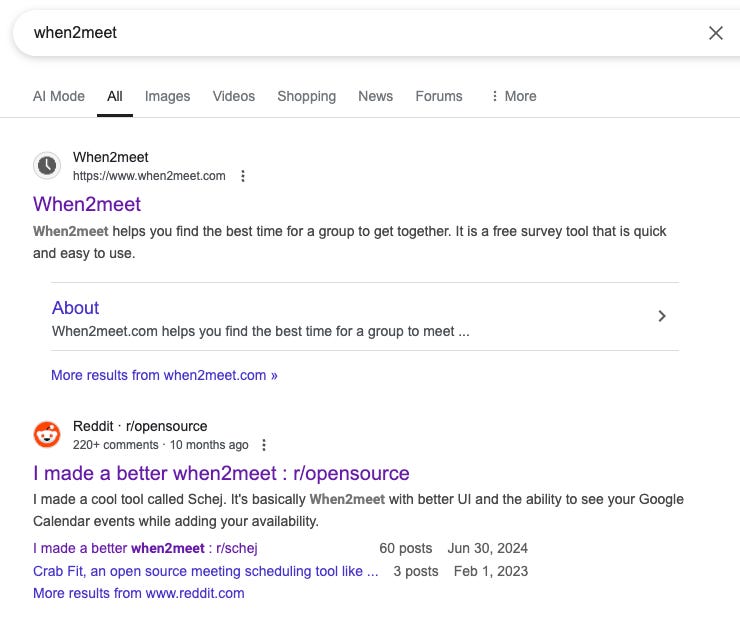A 22-year-old quit Y Combinator to go full time on bootstrapping his college hackathon project
ANOTHER DAY
ANOTHER STARTUP STORY
Whenever you're ready, there are 4 ways I can help you:
1. Promote your business to 1,000+ readers:
Put your business in front of 1,000+ highly-engaged founders, operators, investors, and potential early users at a 35% open rate!
2. Get featured in What A Startup:
Let us tell your story. We’ll write a founder-first feature that highlights your startup journey, traction, and insights — then share it with 1000+ of early-stage founders, builders, and investors.
3. Book a 1-on-1 coaching session with Gracie:
In one hour, let's help you get unstuck and map out an actionable plan to acquire your first 100-1000 customers fast.
4. Get warm intro to 100+ investors and VCs:
I’ll personally introduce you to early-stage investors who are active, founder-friendly, and aligned with your vision — no cold outreach, just real conversations that move things forward.His name is Jonathan Liu, and he’s 22 years old.
When he was still in college, finding a time for group meetings was a familiar pain.
Everyone used When2meet — but it was clunky, feature-limited, and hadn’t evolved much since its early 2000s vibe. So Jonathan had one of those classic startup thoughts:
“There’s gotta be a better way.”
Today, his product — Schej — is that better way. It's an open-source scheduling tool with over 500,000 monthly page views, growing 33% week-over-week at one point. Built to make group scheduling 10x smoother, Schej autofills availability from your calendar, supports multiple time zones, and includes features competitors miss — all based on user feedback.
And here’s the kicker:
Jonathan turned down the VC path after Y Combinator, quit his funded startup doing $2.6K MRR, and went all-in on bootstrapping Schej as a one-person business.
Let’s rewind — and unpack how this all unfolded.
From gaming levels to growth loops
Jonathan started young — like, 12 years old — teaching himself to code so he could build level editors for video games.
In high school, he won a hackathon against adults with a project called Intellecture — a tool for real-time student feedback during lectures.
That spark led him to chase projects over prestige.
“Even during big-tech internships, I was spending more time on my personal projects than my actual work.”
That instinct to build for himself, not for a resume, shaped what came next.
The origin of Schej
The original idea behind Schej was born during college, in the trenches of endless When2meet links and confusing group texts.
So when Google hosted a hackathon, Jonathan told his co-founder:
“Let’s finally build that ‘better When2meet’ idea.”
They did.
And the project didn't just win — it stuck.
The feedback was immediate.
The usage grew.
And unlike past projects (like AssignHub or Intellecture), Schej felt sticky.
It solved a real, repeatable problem — in a way people actually enjoyed.
MORE STARTUP INSIGHTS AND STORIES
🔗 Your startup only needs 1,000 true fans
🔗 10K+ sales pitches later — this will help you land your first customers
🔗 Bill Gates’s daughter just launched her own startup to tackle the $40B fashion problem with AI
🔗 This AI startup hit $15M ARR in 1 year by solving a boring problem
Building with precision (and feedback loops)
Jonathan and his co-founder Tony built the entire product themselves.
They didn’t overthink branding or get distracted by premature scaling.
They focused on making something clearly better:
Autofill availability from Google / Outlook / Apple calendars
Timezone support
Days-only polling
Blind availabilities
CSV export
Email reminders
And every time users left feedback — Jonathan responded personally.
“When we implement their feedback, we tell them directly. They notice.”
That attention to detail created Schej’s biggest growth engine: word-of-mouth from grateful users.
Growth without a dollar spent
Jonathan didn’t start with a paid plan.
Schej was — and still is — free.
But that didn’t stop growth.
He posted a now-viral thread on Reddit titled “I made a better When2meet” in r/opensource, which became the single biggest growth spike.
They grew 33% week-over-week for two months!
Then came SEO optimization, Twitter momentum, and love letters from users.
That post helped kick off an organic growth wave — and today, Schej attracts over 500,000 monthly visitors, all without spending a cent on ads.
One thing was clear: the demand was real.
🔗 Check out his viral Reddit thread here: [ LINK ]
Bootstrapped on purpose
Jonathan isn’t chasing unicorn dreams anymore.
He did the venture-backed route with YC, built a startup doing $2.6K in MRR, and still — he walked away.
“I realized I’m content running a $2-3M lifestyle business.”
Schej is fully bootstrapped.
The goal? — $1M ARR, with no employees.
Just a clean, focused business solving a clear problem — better than anyone else.
What you can steal
Jonathan doesn’t overcomplicate things. His entire approach to building Schej — and everything before it — boils down to a few raw, honest principles.
Solve a problem you personally face.
That’s how Schej was born. He was tired of juggling group meetups using outdated tools. So he built something better — for himself first.Decide early what game you’re playing.
Jonathan tried the VC path. He went through YC, got paying users, hit revenue. But in the end, he chose the bootstrapped route — on purpose. For him, a calm $1M/year solo business beats the pressure of chasing unicorn status.Double down on what works.
Reddit worked. SEO worked. Twitter threads worked. So he leaned into them, instead of constantly chasing shiny tactics.
And if you’re starting from scratch, here’s the exact blueprint he recommends:
Find a real problem.
Form a hypothesis.
Talk to users.
Build a simple MVP.
Iterate like crazy.
It’s not theory.
It’s the exact process that turned a college side project into a 500k-visitor product — and a solo business with serious momentum.
Final thoughts
Jonathan Liu didn’t wait for permission.
He didn’t wait for funding.
He didn’t even wait for the “perfect time.”
He found a problem that annoyed him.
He built a better version.
Then he kept going — quietly, consistently, and with conviction.
There’s a lesson here for every founder chasing momentum:
You don’t need a billion-dollar idea.
You need a real problem, a clean solution, and the courage to bet on yourself.
Schej is proof that small, focused products can go far — especially when they’re built by someone who truly cares.
Maybe try Schej out next time you need to schedule a group meeting: https://schej.it
And if you’re building something — this is a sign to keep it scrappy and keep it real.
THANKS FOR READING!
- Gracie from What A Startup








